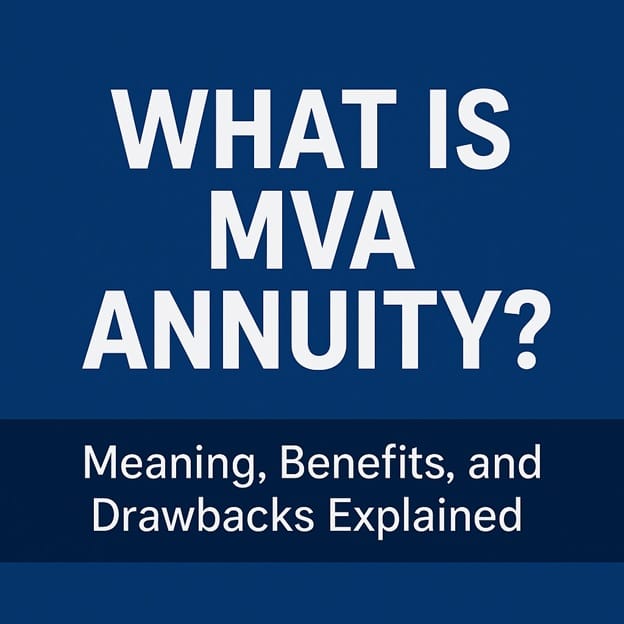Get to know what MVA annuity is, how it works, and what the Market Value Adjustment means to your retirement savings, benefits and risks.
What Is an MVA Annuity?
An MVA annuity, or Market Value Adjustment annuity, is a kind of fixed annuity, which enables insurance firms to alter the value of your annuity in accordance with the fluctuation in market interest rates. Simply put, it is a contract between you and an insurance company in which you make an investment in the form of a lump sum in which you are assured of returns after a set period.
Market Value Adjustment (MVA) is an option that only takes effect in case you decide to withdraw before the expiry of the contract. It modifies the payout you will get either adding or subtracting it based on the relative position of current market interest rates to the interest rates at the time you had bought your annuity.

What Is the Rationale behind Market Value Adjustment?
The MVA is in place to cushion and safeguard both the insurance firms and the policyholders against losses as a result of fluctuating interest rates. In the case of MVA annuity, the insurer invests your funds in bonds and other fixed-income securities. When rates in the market have significantly fluctuated and you withdraw early, the MVA is fair hence will not make unjust to another investor that one of them withdrew early.
In brief, the MVA assists in levelling out the value of the contract and the prevailing market circumstances. It is paying you in case the interest rates fall and a bit goes against you in case of an increase in the rates of interest during your term.
Comparison of Fixed Annuities and MVA Annuities
Although both the fixed and MVA annuities have guaranteed returns, the major distinction is in the way each of them takes care of the early withdrawals.
Fixed Annuity
You get a fixed interest rate over a given time. Withdrawing earlier is subject to surrender fees, however, no correction dependent on interest rates.
MVA Annuity
You get a guaranteed rate, which is still due but in case you withdraw money before the term matures, you will be paid an amount that will be adjusted to the prevailing interest rates in the market. This may result in an upsurge in or downsurge in your payout.
Basically, an MVA annuity provides a means of increase in value in case the interest rates decrease, and in the case of an increase in interest rates, it is subject to decrease.
Mechanism of Market Value Adjustment
The Market Value Adjustment (MVA) operates up to the point of this adjustment matching the value of your annuity with the prevailing interest rates in the market when you withdraw early. It does not carry an annual fee- it is only charged in cases of early withdrawals or surrendering of the contract.
MVA and Interest rate changes
The MVA goes either way depending on the movement of the interest rates following your purchasing of your annuity:
- If interest rates rise:
MVA tends to be negative and this decreases the value you get. This occurs as new investors will be able to acquire higher rates elsewhere leaving your old annuity worth less.
- If interest rates fall:
MVA is typically positive and this augments your payout. Your annuity would be worth more than that which is available in the market today.
Example with Numbers
Considering the following investment, MVA 5 (or 5) annuity of 5 years at 5% guaranteed rate.
- You wish to retire at an early age (after 3 years).
- In January, the market rates stood at 5% but today they are down to 3%.
- Since your rate on the contract is better than the market, the value of your annuity is better also you may have an additional 2-3% bonus to your payment because of a positive MVA.
- Had rates increased to 7 by instead, then your contract is no longer competitive so you could have a contractual payout of a few percent lower because of negative MVA.
When MVA Is Triggered
The Market Value Adjustment is usually used in cases where:
- Before the end of the term, you are giving up the annuity.
- You withdraw before or during the penalty free limit.
- You place your money on another financial product until it matures.
In case you have the annuity to maturity, MVA does not apply and you would be given your full guaranteed value with interest added to it.
The most important characteristics of MVA Annuities
The use of MVA annuity has a number of distinct traits that separate it off the conventional fixed annuity. These characteristics have been made to provide security as well as flexibility, thus, being fit in the hands of investors who want to get a substantial predictability and remain hedged against significant market risk.
Guaranteed Interest Rate Period
Among the most significant benefits of an MVA annuity is the guaranteed interest rate provided over a certain duration of time – normally 3 to 10 years. This will make your investment increase at a consistent rate regardless of the market transition. The insurer, during this period, guarantees you a constant income thus you are assured that your income will remain stable.
Flexibility in Withdrawals and Surgeries Charges
Even though an MVA annuity can be used to promote long term holding, check of part withdrawals each year are still allowed, and they are usually limited to no more than 10% of your account value, without a penalty. Nevertheless, to withdraw over the permitted limit or forfeiting your contract prematurely may also attract a penalty that includes a surrender fee and Market Value Adjustment (MVA). This loose form aids in the reconciliation of liquidity and commitment.
Adjustment of Rates in Early Withdrawals
In case you choose to withdraw or cancel your contract prior to the maturity date, then your payout is eligible to be adjusted with the MVA feature. This modification is based on the interest rates paid in the market at the moment which can be increased or reduced to final payout. This is a mechanism that makes it fair to the entire policyholders as the investment value is maintained in line with the prevailing market conditions.
Insurance Company Backing
Any MVA annuity is being issued by a licensed insurance company, which ensures your principal and interest according to contract. This is what gives MVA annuities a very low-risk investment choice since it is backed by the financial prowess and stability of the insurer. The check of credit ratings of the company should be accomplished prior to buying an annuity as a guarantee of future stability.
Pros of MVA Annuities
Although MVA annuities might appear confusing at first, these have some very good merits to people who appreciate stability and predictable future growth.
Possibility of Increased Guaranteed Returns
The guaranteed interest rates on MVA annuities are usually higher than on other fixed-income investments. Insurers are in a better position to offer better returns since the MVA feature mitigates on them when the interest rates vary where they can compensate long term investors.
Interest Rate Protection Holding to Maturity
In case you maintain your MVA annuity till the end of the guaranteed period, Market Value Adjustment will not be applicable and you will reap the full amount promised. That is, your income will not be subject to market fluctuations, another significant advantage of long-term retirement planning.
Secured Investment Option – Insurers
The MVA annuities are also characterized by stability and principal protection. The issuing insurance company guarantees your initial investment and the interest collected on it making it one of the safest methods of generating a predictable income, particularly among retirees.
Tax-Deferral Growth Benefits
Similar to the majority of annuities, an MVA annuity enables your income to have a tax-deferred growth until the moment you start withdrawing it. This implies that you do not pay tax on interest every year and this way your investment will be able to grow more appropriately over time.
Cons of MVA Annuities
MVA annuities have several positive aspects but they are not flawless. They are accompanied by some limitations of which the investors must take caution before buying.
Punishments on Premature Withdrawals
Withdrawing your funds earlier than the expiry of the surrender period will mean you will be charged a surrender fee and even negative MVA adjustment. Such penalties have the ability of cutting down your payout rendering early withdrawal a very costly choice.
Complicated to New Investors
Market Value Adjustment is a complex mechanism that often proves to be a jumble to a person unfamiliar with the annuities or fixed-income investment. Some financial expertise is needed in the understanding of the impact of changing interest rates on your payout.
Potential Negative Adjustment in an Upturn in the interest rates
Increasing market interest rates following your acquiring your annuity by a large margin and you retire early, then the MVA may lower your worth. This is because your fixed rate contract will be less appealing than newer contracts that have higher returns.
Low Liquidity in Comparison to other investments
MVA annuities are not meant to be accessed in the short term but rather in the long term. Although this has restrictions on the amount of penalty-free withdrawals, this does not give it the liquidity as a savings account or a mutual fund. Thus, one should only spend money that is not necessary in the near future.
Pre-investment tips MVA Annuities
It is good to know the most important terms, conditions, and financial implications of an MVA annuity before you make a decision to invest in it. These annuities may be a great addition to a retirement portfolio, but one should evaluate their options thoroughly so as to receive the maximum out of their investment.
Check Surgery and Company Rating
Any MVA annuity has a surrender period, which is typically between 3-10 years. Surgery charges and a Market Value Adjustment could be initiated due to early withdrawals during this period.
The financial strength and credit rating of the insurance company that provides the annuity must be checked before investing. The fact is that reputable rating agencies such as A.M. Best, Moody, or Standard and Poor give us the information concerning the reliability of the company and its capability to fulfill its future commitments.
Request the Interest Rate Guarantee Term
The interest rate guarantee specifies the number of years that your annuity is going to receive a constant rate of interest. Ensure that you know whether the rate is fixed throughout the contract or it can be changed after a certain duration.
Request your insurer to give you concise paperwork on the way interest rate is computed and what happens upon the expiry of the first term of guaranteed interest.
MVA vs Non-MVA Comparisons
Compare MVA annuity to Non-MVA annuity (traditional fixed annuity) before selecting an MVA annuity.
- MVA Annuity: High interest rates may apply but there is a market-based adjustment to take into consideration the early withdrawals.
- Non-MVA Annuity: Has simpler terms not adjusted, but normally at a marginally lower rate.
Depending on how much you are comfortable with the changes in interest rates and liquidity requirements, you want to choose the right one.
Learn Withdrawal Clauses
Always know the rules of withdrawal of your contract. Majority of the MVA annuities permit 10 percent yearly withdrawals without penalty. Anything beyond that limit or turning in early may lead to a charge or negative MVA.
In case you are likely to require the use of your funds at a regular rate, you may opt to use a more dynamic investment choice.
Conclusion
An MVA annuity (Market Value Adjustment annuity) is a potent financial instrument of a person who aims to have stable and predictable returns with the assurance of market instability. It is a fixed income security with a system that is likely to be fair in adapting to the market rates.
Being held to maturity, MVA annuity guarantees a growth and the absence of worries, which is why it is a worthy investment into a long-term retirement strategy. Nevertheless, penalties and adjustments may be caused when one makes early withdrawals and therefore it is important to invest on a long term basis.
Is this a purchase based on your financial objectives, liquidity requirements and market outlook? And lastly, never hesitate to hire a licensed financial advisor in order to select the appropriate annuity product that will fit in your retirement plan.
FAQs About MVA Annuities
What does MVA stand for in annuities?
MVA stands for Market Value Adjustment. It’s a feature that adjusts your annuity’s payout value based on current market interest rates when you withdraw or surrender your policy before maturity.
Is MVA good or bad?
MVA isn’t inherently good or bad — it’s a neutral mechanism that ensures fairness based on market conditions. If interest rates fall, MVA can increase your payout. If rates rise, it can reduce your payout during early withdrawals.
How does MVA affect my annuity value?
MVA only affects your annuity’s value if you withdraw funds before the end of the surrender period. Depending on whether interest rates have risen or fallen, it can positively or negatively impact your payout amount.
Can I lose money in an MVA annuity?
You won’t lose your principal if you hold your annuity until maturity. However, if you withdraw early during a period of rising interest rates, a negative MVA adjustment might reduce the amount you receive at that time.
What happens if I withdraw early from an MVA annuity?
Early withdrawals from an MVA annuity may trigger:
- Surrender charges (a penalty for early exit)
- A Market Value Adjustment, which can either increase or decrease your payout based on interest rate changes. To avoid losses, it’s best to keep your annuity until the end of its guaranteed term.



































